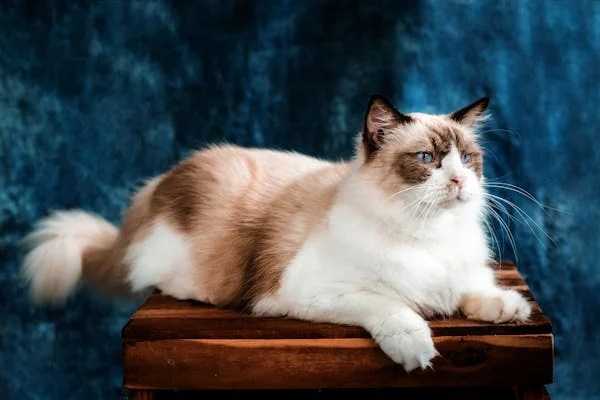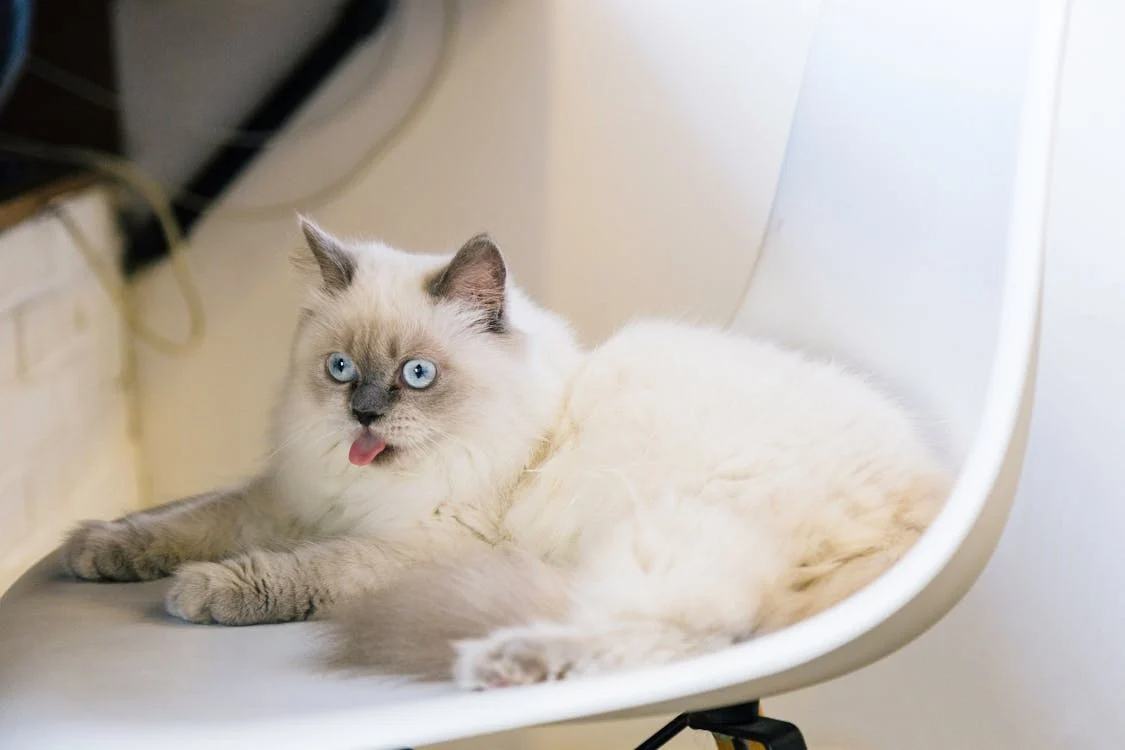Ragdoll cats are known for their large size, striking blue eyes, and affectionate personalities. As one of the largest domestic cat breeds, Ragdolls are prone to weight gain if not properly managed. Maintaining a healthy weight is essential to their overall well-being. Obesity in cats can lead to serious health problems, including joint issues, diabetes, and heart disease.
In this article, we will provide a step-by-step guide to help you determine if your Ragdoll cat is overweight, discuss the risks of obesity, and offer actionable tips for managing your cat’s weight.
Ideal Weight for Ragdoll Cats
Ragdolls are a large breed, and their weight can vary depending on factors such as gender, age, and activity level. Generally, the weight ranges for a Ragdoll are as follows:
- Male Ragdolls: 10 to 20 pounds (4.5–9 kg)
- Female Ragdolls: 8 to 15 pounds (3.5–6.8 kg)
Despite these ranges, it’s essential to focus not just on the numbers but on the overall body condition. A healthy Ragdoll cat should have a balanced proportion of body fat and muscle mass, rather than excessive weight gain.
How to Tell if Your Ragdoll Cat Is Overweight
1. Lack of a Defined Waistline
When you look at your Ragdoll from above, a healthy cat will have a clear waistline behind the ribs. If your cat has a rounded or straight silhouette without a noticeable waist, they may be carrying extra weight.
2. Difficulty Feeling Ribs
One of the easiest ways to assess whether your cat is overweight is by feeling their ribs. Run your hands along their sides. In a healthy cat, the ribs should be easily palpable with a slight fat covering. If the ribs feel hidden beneath a thick layer of fat, this could indicate obesity.
3. Abdominal Fat Deposit or “Fat Pad”
Ragdolls, like many cats, may develop an abdominal fat pad if they are overweight. This is typically noticeable as a sagging belly or a noticeable bulge in the lower abdomen. While a small amount of fat in this area is normal, excessive fat could signal that your cat is carrying extra weight.
4. Decreased Activity Levels
Overweight cats often become more sedentary. If your Ragdoll has stopped playing as much or seems sluggish, it could be due to the strain that extra weight puts on their joints and muscles. This reduced activity can, in turn, lead to further weight gain.
5. Breathing Issues and Lethargy
If your Ragdoll seems out of breath after minimal exertion or appears tired more frequently, this can be a sign that they are overweight. Obesity can place additional stress on their respiratory system, leading to difficulty breathing, especially after activity. These are just averages. Physical condition and activity levels matter more than a specific number.
Using the Body Condition Score (BCS) to Assess Your Cat’s Weight
Veterinarians often use the Body Condition Score (BCS) system to assess the weight and body condition of cats. The BCS is a scale from 1 to 9, where:
- 1/9: Severely underweight
- 4-5/9: Ideal body weight
- 6-7/9: Overweight
- 8-9/9: Obese
For a healthy Ragdoll, the goal is to have a score of 4 to 5/9, where the ribs are easily palpable, there’s a defined waistline, and there’s only a slight abdominal tuck. If your Ragdoll falls into the higher end of the scale (6-9), they may be overweight or obese.
The Health Risks of Obesity in Cats
Obesity in cats is not just a cosmetic issue—it can significantly impact their health, leading to:
- Diabetes Mellitus: Obesity increases insulin resistance, making your cat prone to diabetes. This condition requires lifelong management and can be costly.
- Joint Pain and Arthritis: Excess weight strains the joints, leading to pain, stiffness, and reduced mobility.
- Heart Disease: Extra fat stresses the heart, increasing the risk of cardiovascular problems.
- Respiratory Issues: Overweight cats often struggle to breathe properly, especially during exercise.
- Fatty Liver Disease (Hepatic Lipidosis): This life-threatening condition is more common in overweight cats, particularly if they stop eating suddenly.
- Reduced Lifespan: Studies have shown that overweight cats live shorter lives and suffer from reduced quality of life compared to their healthier counterparts.

What Causes Weight Gain in Ragdoll Cats?
Understanding why your Ragdoll is gaining weight is the first step toward addressing the issue. Common causes include:
1. Overfeeding
- Free feeding (leaving food out all day) encourages overeating.
- Offering too many treats or human food can add hidden calories.
2. Low Activity Levels
- Ragdolls are naturally relaxed and less active than other breeds. Indoor cats, in particular, may struggle to get enough exercise.
3. Age and Metabolism
- As cats age, their metabolism slows, and they require fewer calories to maintain their weight.
4. Poor Diet
- Low-quality cat foods with high fillers (such as corn or wheat) contribute to weight gain without providing proper nutrition.
5. Genetics
Ragdolls are predisposed to gain weight, especially without regular activity and portion control.
How to Help Your Ragdoll Cat Lose Weight
If you’ve determined that your Ragdoll is overweight, follow these steps to help them get back to a healthy weight:
1. Adjust Their Diet
- Portion Control: Use a measuring cup to feed the right amount based on their ideal weight. Avoid free-feeding.
- High-Quality Food: Switch to a high-protein, low-carbohydrate cat food. Wet food can be particularly beneficial as it’s lower in calories and higher in moisture.
- Limit Treats: Treats should account for no more than 10% of your cat’s daily calorie intake. Opt for low-calorie treats when necessary.
2. Encourage Physical Activity
- Interactive Play: Use feather wands, laser pointers, or moving toys to engage your cat in active play.
- Create Climbing Opportunities: Invest in cat trees, shelves, or window perches to encourage your cat’s natural movement.
- Chasing Games: Encourage your cat to chase balls or toys around the house.
- Puzzle Feeders: Use treat-dispensing toys to combine mental stimulation with physical activity.
3. Regular Monitoring
- Weigh Your Cat Weekly: Use a pet scale or weigh yourself holding your cat and subtract your weight.
- Track Food and Activity: Keep a journal of their meals, treats, and playtime to monitor progress.
How to Prevent Obesity in Ragdoll Cats
Preventing obesity is easier than reversing it. Here are some proactive steps:
- Establish Healthy Habits Early: Feed portion-controlled meals from the start.
- Maintain Regular Playtime: Incorporate exercise into their daily routine, even if they seem disinterested at first.
- Monitor Treats and Snacks: Be mindful of how often you’re rewarding your cat with high-calorie treats.
When to Consult a Veterinarian
If your efforts don’t seem to make a difference, consult your veterinarian. They can:
Provide prescription food or medications if necessary.
Rule out underlying health conditions such as hypothyroidism.
Create a customized weight-loss plan, including specific diet recommendations.
Conclusion
Maintaining your Ragdoll cat’s ideal weight is crucial for their health, happiness, and quality of life. By understanding their unique breed characteristics, monitoring their body condition, and implementing a balanced diet and exercise plan, you can help them achieve and maintain a healthy weight.
A healthy Ragdoll is a happy companion. The steps you take today can lead to a longer, more fulfilling life for your beloved pet. When in doubt, work closely with your veterinarian to ensure your cat receives the best care possible.

Hey guys, My name is Simon Smith. I’m from Canada and live near Victoria
I live with my sweet family and have 20+ Ragdolls of different types. I love them as my children. My profession is as a hotel manager.
I love to keep Ragdolls and grow their breeder case. I have 7 years of experience.
I’m an expert in cat care. So, I’m here to provide you with new information about my cats daily. This is my blog website, so I request that you kindly visit our site daily.
If you’re a Ragdolls lover and you have any questions or confusion about cats, text me on the Contact Us page or Gmail.
Thank u
